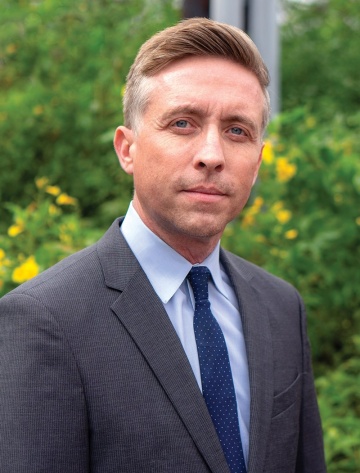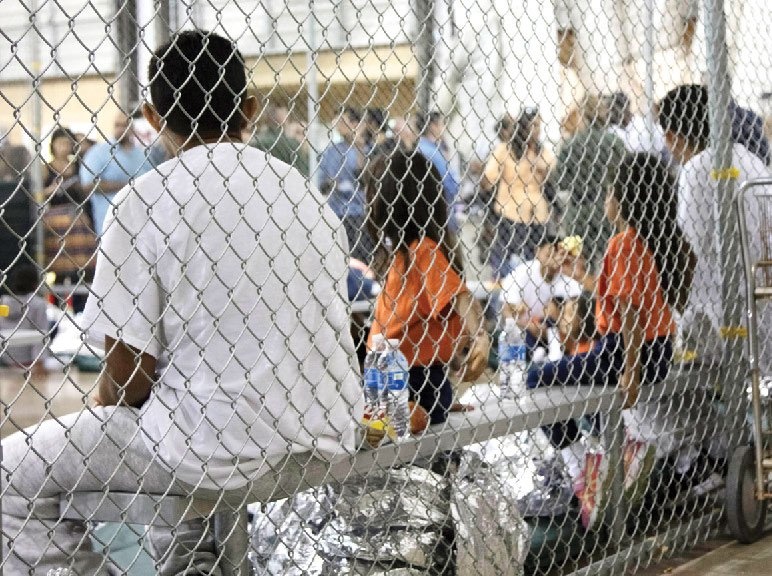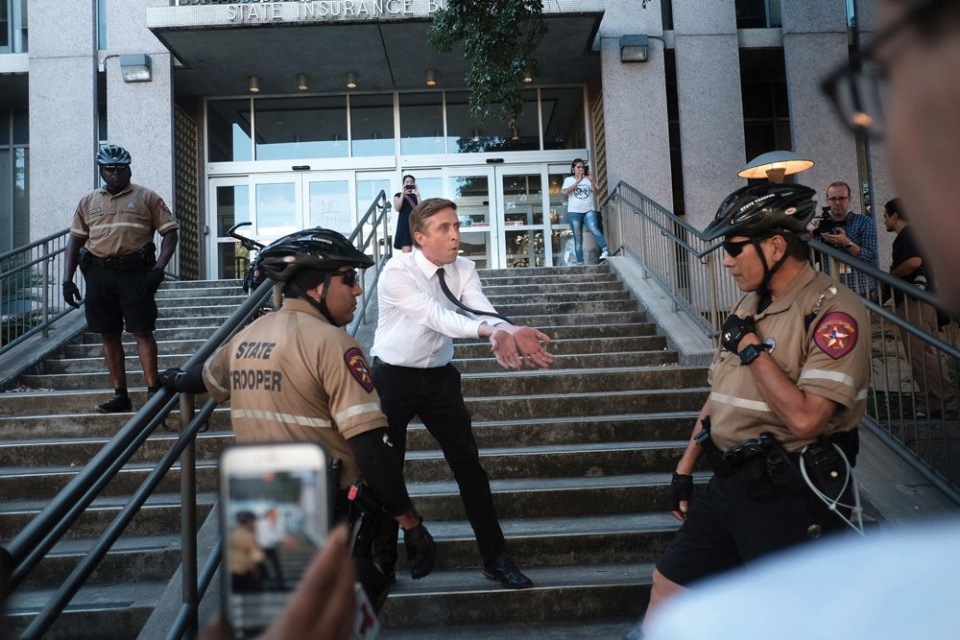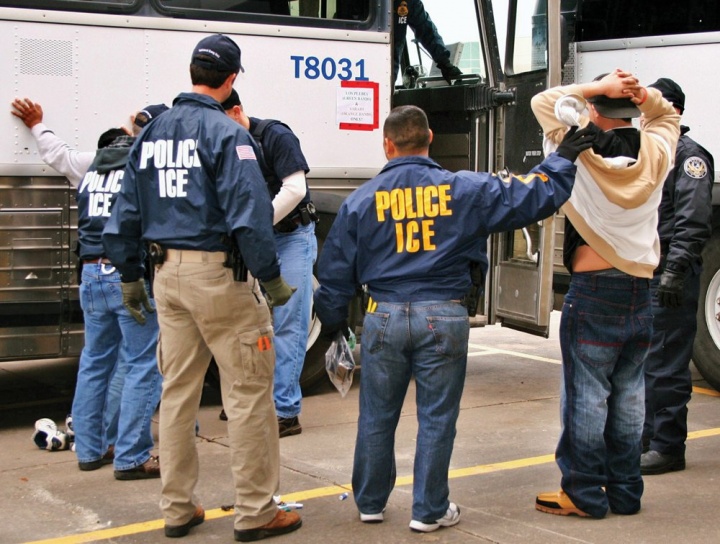Immigration lawyer Jonathan Ryan ’00 is helping fractured families at the border.
Columbia College | Columbia University in the City of New York
Immigration lawyer Jonathan Ryan ’00 is helping fractured families at the border.
The Trump administration’s family separation mandates may have sent the world reeling last summer, but Jonathan Ryan ’00 wasn’t all that surprised. As the director of the Austin-based Refugee and Immigrant Center for Education and Services (RAICES), Ryan sensed trouble at the border long before the detention of immigrant children became front-page news. The legal problems faced by traumatized migrants, asylum seekers, frantic parents and frightened minors had in fact formed the fabric of his work for years.

Jonathan Ryan ’00
Courtesy RAICES
Ryan’s own experience at the border was what pushed him to become an immigration attorney in the first place. Shortly after
9-11, Ryan, who was born in Canada to an Irish immigrant family, went to Mexico for the holidays. When he tried to cross back into the United States, where he was attending law school at the University of Texas-Austin (UT-A), he realized his green card had expired and was detained until his father was able to come get him.
While his fellow travelers — some of them parents with young children — languished in detention in Mexico, “I showed up at the border in the back of my parents’ Mercedes, with my white privilege packaged around me,” Ryan recalls. “The border patrol guy looked at my car, looked at me, carved something with his pen on the back [of my green card] and just told me to get it renewed — and we drove right into the United States.” Ryan became a U.S. citizen shortly thereafter, and “point to point, from that day [at the border] to right now, it’s been a single experience.”

A cage at the U.S. Border Patrol Central Processing Center in McAllen, Texas, on June 17, 2018. It holds people who were taken into custody related to cases of illegal entry into the United States.
U.S. CUSTOMS AND BORDER PROTECTION
The realization that borders exist for some people more than others, and that this discrepancy often falls along racial and class lines, compelled Ryan to volunteer for cases at UT-A’s immigration law clinic as soon as he got back to school. After a stint at a local legal nonprofit, he joined RAICES, which provides free or low-cost legal services to immigrants and refugees.
Though Ryan now spends much of his time liaising with the media and donors, he continues to practice and be involved in operations on the ground. For example, he recently helped defend a Deferred Action for Childhood Arrivals (DACA) recipient who had participated in a protest outside the Immigration and Customs Enforcement office in San Antonio. “He was targeted, arrested and deported for his exercise of his First Amendment [right],” Ryan says. “I represented him and worked with his family from the day he was arrested.”
In recent months, RAICES has made headlines for spreading awareness about family separations, speaking out against the travel ban, raising millions of dollars to help refugees and migrants, and turning away a quarter-million-dollar donation from cloud computing firm Salesforce because of its ongoing contract with the Department of Homeland Security (DHS).
In October, Ryan talked with Columbia College Today about his decade with RAICES and his perspective on how things have — and haven’t — changed since Trump took office.
Q: How did your detention at the U.S.-Mexico border inform your career?
A: When I got back to school, I immediately found an immigration clinic. The professor told me to buzz off because I was a 1L, so I told her what had just happened to me, and she relented. I was so deep in it, there was nothing else I could do and I basically transitioned right into practice. I interviewed three times at the local immigration nonprofit [after graduation] and when I didn’t get the job, I said [to them], “This is what I want to do with my life; this is what I’ve built up everything to do. If I’m not getting this job, there’s a problem.” And they hired me.

Ryan demanded to be let into a building in Austin, Texas, where demonstrators were being arrested on April 30, 2018.
Courtesy Jorge Sanhueza-Lyon / KUT News
A: We’ve accustomed ourselves to the portability of our identities in so many ways, yet with respect to our citizenship or the nation-state itself, we still adhere as people to a notion that is really arcane and archaic, like the subjects clustered around the castle. But the question that is really foremost in my experience in Mexico, and in the experience of thousands of clients with whom I’ve worked in the last dozen years, is, Who has the power to do what to me?
Q: Has there been a sea change in the way the U.S. is handling immigration since Trump took office?
A: No. The very worst laws that we have on the books were passed by Democratic presidents.
We’re living in a country where children and parents are [detained] in a for-profit prison system together. In a country that has pushed a deterrence strategy to stop refugees from coming to our border. In a country that has penned declarations [labeling] women and children fleeing violence and seeking asylum at the southern border a top threat to our national security.
That is not [just] the country of Donald Trump that I am describing. Everything that I just said to you took place in 2014 under President Barack Obama ’83. All Trump is doing is stepping on the gas. He has not had to do anything. He has not had to build anything. He has just continued and advanced and increased the [existing] policies and mechanical structures. And what has facilitated this, in the 12 years since I’ve been doing immigration law, is this explosion of for-profit prisons and immigration detention.
Of course, it would be disingenuous of me to say that there’s not something new and different and more dangerous about this presidency. But I think it’s only the other side of the same coin.

A caravan of migrants with plans to reach the United States crossed into Mexico from Guatemala on October 21, 2018.
John Moore / Getty Images
Q: As the family separations blew up the news last summer, what was it like from your vantage point at RAICES?
A: We’ve been seeing family separation for many years. That was not a new policy, [although it] certainly was expanded and has increased. The reason that we grew from being an organization of four people to 150 people in 10 years was not [anything I did] — as much as I’d love the story being about me as an entrepreneurial nonprofit CEO tycoon. It’s that we’ve been responding to crisis constantly during the past 10 years. [Last summer’s crisis] was much bigger, to be sure, but we are quite used to doing the work in these moments...It was a tumultuous summer, there’s no doubt about it, but the disruption, for us, was about managing the media and the shock and horror of the American people, for whom this was new.
Q: Some Democrats who were upset about the family separations, like Marc Pocan (D-Wis.) and Pramila Jaypal (D-Wash.), have called for the abolishment of Immigration and Customs Enforcement. Do you think “Abolish ICE” is a useful protest slogan?
A: I support the abolition of ICE. But to take ICE away, and merely to replace it with — what? The military? Some other enforcement branch of the government? That’s not enough. ICE is the wrapper around racist, xenophobic and violent policies and people. So I don’t see ICE as the root cause; I think you have to dive deeper. Our government is trying to make the experience of refugees seeking protection so similar to the horror that they are fleeing that they decide to go back, that they decide that it was better back where they were. That is the problem.

ICE special agents arresting suspects during a raid.
Courtesy ICE
A: I think that there is a lot of effort undertaken through training and corporate culture to further the dehumanization of immigrants, thus enabling human beings to perpetrate violence against other human beings without always realizing that that is what they’re doing. Very few people whom we encounter within ICE or the Border Patrol or other agencies consider themselves to be that agent of terror. In fact, we sometimes encounter agents and officers who point to other parts of their own bureau and say, “Those are the bad guys. I’m just doing my job.”
Q: Your organization got some press last year when it rejected a $250,000 donation from the tech company Salesforce. What went into that decision?
A: The decision to reject the Salesforce money did not take even five minutes. It was a transparent and overt attempt at handwashing on the part of a multi-billion-dollar corporation that was under pressure — internally and externally.
Q: What is it going to take to change this anti-immigration regime, and where do you see yourself in that fight?
A: I am a lawyer, but I recognize that the law is downstream of culture, and culture itself is downstream of art. I don’t think that we’re going to legislate or sue our way out of this situation. If you look back in history, Brown v. Board of Education was decided in the ’50s. That did not stop segregation in schools. The real changes of Brown were not made until people took to the street in the ’60s. You look back at every significant change or improvement to our law and our societies, and it has been through the direct action of people, masses of people, taking to the street, raising their voice, showing solidarity and taking risks.
There isn’t going to be a comfortable way out of this. It’s going to take sacrifice. All of these moments, from the revolution to civil rights, to the ending of slavery, to women’s suffrage, to gay rights — we, in retrospect, apply that narrative of inevitability, but that was not the case in real time.
Atossa Araxia Abrahamian ’08, JRN’11 is a senior editor at The Nation and the author of The Cosmopolites: The Coming of the Global Citizen.

Published three times a year by Columbia College for alumni, students, faculty, parents and friends.
Columbia Alumni Center
622 W. 113th St., MC 4530, 6th Fl.
New York, NY 10025
212-851-7852
cct@columbia.edu

Columbia Alumni Center
622 W. 113th St., MC 4530, 4th Fl.
New York, NY 10025
212-851-7488
ccalumni@columbia.edu